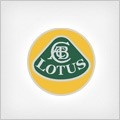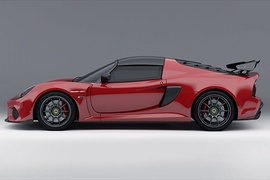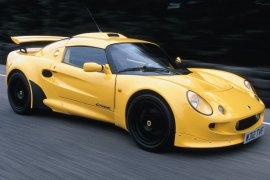
LOTUS Exige
Generations Timeline, Specs and Pictures

Lotus considered that a special car needed a unique, final edition, and it proved that with the introduction of the Exige Sport 420 Final Edition at the beginning of 2021.
After 21 years since the start of the Exige series, Lotus regained its past glory. It started with the Elise and continued with its coupe cousin, the Exige. Over time, the two vehicles shared many of their components and increased Lotus’ value on a market that almost forgot the former British glorious brand that stunned the Formula One world.
At the front, the Exige kept its four-headlights design with clear glass over them. A special bumper with an integrated center grille and two side pods increased the aerodynamic downforce. On the front fenders, the carmaker installed specific stickers that marked the last Exiges. Regardless of the car’s color, ell the 420 Special Editions featured a black roof. A black wing mounted on the back panel kept the car planted during fast cornering.
Inside, the carmaker installed race bucket-seats with race-harness. They were upholstered in Alcantara and red, contrast stitches. The steering wheel was thicker and wrapped in Alcantara as well, and the same material was used for the door panels. For the instrument cluster, Lotus installed a TFT display with a choice of two screens: one with regular dials and the other with race-type information.
Lotus installed a re-tuned V-6 engine in the 420 Final Edition that provided 420 hp. It was the fastest Exige ever made, with a top speed of 180 mph (295 kph). It could rocket from 0 to 60 mph in 3.3 seconds.

Lotus introduced a final run for the Exige model adding a few extra goodies and offering it as a track-focused car or a better all-rounder.
The Exige was the sports car for those who needed more power than the Elise, for those who didn’t want to stop on the right side of the road and cover it if the rain started. Moreover, it offered a supercharged V-6 instead of an inline-four. For short, it was a better daily driver. Maybe not as good as a Boxster, but it was much more exclusive.
Exige was the car that, along with the Elise, helped Lotus survive on the market, and the British brand had to say a big “thank you” for that. The 2021 Final Edition 390 was the right way to do it. It was offered in a specific color scheme and added black door mirrors, wing, and aerodynamic details.
Inside, Lotus made the car for mixed driving. It wasn’t that bare-bone cabin fit for racing but offered some comfort. The Final Edition 390 featured leather sport bucket-seats with high bolstering and nicely padded door-panels. But the main change was for the instrument panel that was changed from analog dials to a TFT display with two screens: one for daily driving and another for track use.
Exige Final Edition 390 featured the same supercharged V6 from the rest of the range tuned to offer 390 hp to the rear wheels via a six-speed manual gearbox. It was the least powerful version of the Exige Final Edition, tuned for better street use. The kind of car that the owner won’t trailer it to and back from the track.

In 2017 Lotus announced a new and more exciting Exige, with the new Sport 410.
It was designed to be the ultimate road driving car, without any rival in its category.
The latest Exige range has an advanced chassis, suspension, and powertrain for better performance on the road and on the track. The 3.5-liter supercharged engine has a 410 hp and 420 Nm (310 lb-ft) of torque sent to the rear wheels via a six-speed transmission.
Lotus has made a name of itself due to very light vehicles and a high power-to-weight ratio. The new Exige 410 Sport is not an exception but more like a confirmation. It has 389 hp/tonne (dry weight). Due to this, the performance is at a high level with a 0-100 kph (0-62 mph) acceleration time of 3.3 seconds and a top speed of 290 kph (180 mph). For a good road-holding, the Exige Sport 410 has an aerodynamic package that generates up to 150 kg (330 lbs) of downforce.
But the performance on the road is nothing without pleasure. This is why the Exige Sport 410 is also offered as a roadster, to offer the original pleasure of driving with the top-down as the original Lotus was built. And, for a personal touch, the customers can personalize their car with the Lotus Exclusive program, which combines traditional British craftsmanship with modern design.

Alongside the improved power to weight ratio, the new Lotus Exige S has a completely new exterior and interior.
On the outside it comes with a new front spoiler, redesigned headlamps, rear spoiler, taillamps and side skirts along other minor details. The interior is available in two styles - Premium and Premium Sport. A Lotus DPM (Dynamic Performance Management) switch allows the driver to switch between three driving modes: Touring, Sport and DPM off. An additional Race Pack option can be had, placing the Race mode on the switch along with other features like Launch Control and an optimized suspension.

The Exile was one of the most focused from-the-factory performance car available in the US.
For 2008, the new Exige S 240 had 20 hp extra compared to the previous model, thanks to the roof-mounted air scoop designed to force more air into the supercharger. The small track vehicle had a 1.8-liter 4-cylinder engine that developed 220 hp. While it might not sound much, the light weight body helped it reach 100 kph in around 4.1 seconds, which was similar to other sports cars with around 500 hp.
The 2-seater, high performance coupe, was available in two styles: the Exige S and the Exige S 240 . The standard equipment for the Exige S included 16-inch alloys in the front and 17-inch at the back, ventilated brakes, a performant suspension, air conditioning, power windows and lock, as well as nicely crafted sport seats with black cloth upholstery and a 4-speaker audio system.
The more powerful Exige S 240 had larger brake discs, a variable traction control and launch control.
Available for both version, the Touring Pack included additional sound insulation, an auxiliary audio jack and leather upholstery, leather door panels, leather handbrake and a leather-wrapped center console.
Safety wise, the Exige only came with ABS and traction control, however, stability control and airbags were not available. And it only makes sense, as the Exige needed to be as light as possible to perform well on the track.

In production since 2004, the Series 2 Exige is available with two engine configurations, both based on an 1.8L L4, multipoint injection solution. Customers can choose between 192 HP and 133.5 pound-feet of torque and 225 HP and 133.5 pound-feet of torque, but otherwise the two versions are quite identical. Rear wheel drive, manual, 6-speed transmission and all round ventilated discs are standard. The design changes, which included the front splitter, fibreglass hardtop roof with roof scoop, rear engine cover, and rear spoiler, were aimed at creating more downforce, considerably more downforce.

After introducing the Elise on the market, Lotus was pressed by its customers to build a coupe version for it and the Exige was born.
Usually, a roadster is heavier than its coupe sibling. But Lotus did the Exige the other way around and made it heavier than its Elise sibling. They just put a fixed cover over the Elise already rigid chassis. The good part was that it didn’t spoil the hairstyle with the windows closed.
When Lotus made a closed cabin for the Exige, it used the new shapes to create a new air-duct for the engine on top of the car. But the front remained similar to its open-top sibling, the Elise. At the front, it featured a sharp nose with two extraction vents on the upper panel. Its round headlights were pushed outward on the fenders while the turn-signals were on the inner side. Exige’s new profile brought new aerodynamic advantages and better use for a rear wing. The overall curved shapes provided a better drag-resistance factor and led to a higher top speed than on the Elise.
The interior was very similar to the one in the Elise, but the AC was fitted as standard. On the other hand, the windows used an old-fashioned cranked system. But Lotus considered that the car should offer more comfort features and added Alcantara on the doors and sills.
Under the hood, Lotus used the same K-Series Rover engine, but only on the top power version, which provided 179 hp. The less-powered units were used only on the Elise.























































